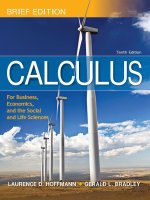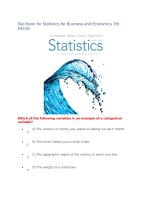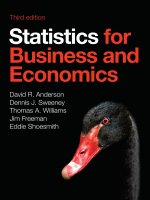Statistics for business economics 7th by paul newbold chapter 04
Bạn đang xem bản rút gọn của tài liệu. Xem và tải ngay bản đầy đủ của tài liệu tại đây (517.78 KB, 52 trang )
Statistics for
Business and Economics
7th Edition
Chapter 4
Discrete Random Variables and
Probability Distributions
Copyright © 2010 Pearson Education, Inc. Publishing as Prentice Hall
Ch. 4-1
Chapter Goals
After completing this chapter, you should be
able to:
Interpret the mean and standard deviation for a
discrete random variable
Use the binomial probability distribution to find
probabilities
Describe when to apply the binomial distribution
Use the hypergeometric and Poisson discrete
probability distributions to find probabilities
Explain covariance and correlation for jointly
distributed discrete random variables
Copyright © 2010 Pearson Education, Inc. Publishing as Prentice Hall
Ch. 4-2
Introduction to
Probability Distributions
4.1
Random Variable
Represents a possible numerical value from a
random experiment
Random
Variables
Ch. 4
Discrete
Random Variable
Copyright © 2010 Pearson Education, Inc. Publishing as Prentice Hall
Continuous
Random Variable
Ch. 5
Ch. 4-3
Discrete Random Variables
Can only take on a countable number of values
Examples:
Roll a die twice
Let X be the number of times 4 comes up
(then X could be 0, 1, or 2 times)
Toss a coin 5 times.
Let X be the number of heads
(then X = 0, 1, 2, 3, 4, or 5)
Copyright © 2010 Pearson Education, Inc. Publishing as Prentice Hall
Ch. 4-4
4.2
Discrete Probability Distribution
Experiment: Toss 2 Coins.
Let X = # heads.
Show P(x) , i.e., P(X = x) , for all values of
x:
4 possible outcomes
Probability Distribution
T
H
H
T
H
T
H
Copyright © 2010 Pearson Education, Inc. Publishing as Prentice Hall
x Value
Probability
0
1/4 = .25
1
2/4 = .50
2
1/4 = .25
Probability
T
.50
.25
0
1
2
x
Ch. 4-5
4.3
Probability Distribution
Required Properties
P(x) 0 for any value of x
The individual probabilities sum to 1;
P(x) 1
x
(The notation indicates summation over all possible x values)
Copyright © 2010 Pearson Education, Inc. Publishing as Prentice Hall
Ch. 4-6
Cumulative Probability Function
The cumulative probability function, denoted
F(x0), shows the probability that X is less than or
equal to x0
F(x 0 ) P(X x 0 )
In other words,
F(x 0 ) P(x)
x x 0
Copyright © 2010 Pearson Education, Inc. Publishing as Prentice Hall
Ch. 4-7
Expected Value
Expected Value (or mean) of a discrete
distribution (Weighted Average)
μ E(X) xP(x)
x
Example: Toss 2 coins,
x = # of heads,
compute expected value of x:
x
P(x)
0
.25
1
.50
2
.25
E(x) = (0 x .25) + (1 x .50) + (2 x .25)
= 1.0
Copyright © 2010 Pearson Education, Inc. Publishing as Prentice Hall
Ch. 4-8
Variance and Standard
Deviation
Variance of a discrete random variable X
2
2
2
σ E(X μ) (x μ) P(x)
x
Standard Deviation of a discrete random variable X
σ σ2
2
(x
μ)
P(x)
x
Copyright © 2010 Pearson Education, Inc. Publishing as Prentice Hall
Ch. 4-9
Standard Deviation Example
Example: Toss 2 coins, X = # heads,
compute standard deviation (recall E(x) = 1)
σ
2
(x
μ)
P(x)
x
σ (0 1)2 (.25) (1 1)2 (.50) (2 1)2 (.25) .50 .707
Possible number of heads
= 0, 1, or 2
Copyright © 2010 Pearson Education, Inc. Publishing as Prentice Hall
Ch. 4-10
Functions of Random Variables
If P(x) is the probability function of a discrete
random variable X , and g(X) is some function of
X , then the expected value of function g is
E[g(X)] g(x)P(x)
x
Copyright © 2010 Pearson Education, Inc. Publishing as Prentice Hall
Ch. 4-11
Linear Functions
of Random Variables
Let a and b be any constants.
a)
E(a) a
and
Var(a) 0
i.e., if a random variable always takes the value a,
it will have mean a and variance 0
b)
E(bX) bμX
and
2
Var(bX) b σ
2
X
i.e., the expected value of b·X is b·E(x)
Copyright © 2010 Pearson Education, Inc. Publishing as Prentice Hall
Ch. 4-12
Linear Functions
of Random Variables
(continued)
Let random variable X have mean µx and variance σ2x
Let a and b be any constants.
Let Y = a + bX
Then the mean and variance of Y are
μY E(a bX) a bμX
σ
2
Y
2
Var(a bX) b σ
2
X
so that the standard deviation of Y is
σY b σX
Copyright © 2010 Pearson Education, Inc. Publishing as Prentice Hall
Ch. 4-13
Probability Distributions
Probability
Distributions
Ch. 4
Discrete
Probability
Distributions
Continuous
Probability
Distributions
Binomial
Uniform
Hypergeometric
Normal
Poisson
Copyright © 2010 Pearson Education, Inc. Publishing as Prentice Hall
Ch. 5
Exponential
Ch. 4-14
4.4
The Binomial Distribution
Probability
Distributions
Discrete
Probability
Distributions
Binomial
Hypergeometric
Poisson
Copyright © 2010 Pearson Education, Inc. Publishing as Prentice Hall
Ch. 4-15
Bernoulli Distribution
Consider only two outcomes: “success” or “failure”
Let P denote the probability of success
Let 1 – P be the probability of failure
Define random variable X:
x = 1 if success, x = 0 if failure
Then the Bernoulli probability function is
P(0) (1 P) and P(1) P
Copyright © 2010 Pearson Education, Inc. Publishing as Prentice Hall
Ch. 4-16
Bernoulli Distribution
Mean and Variance
The mean is µ = P
μ E(X) xP(x) (0)(1 P) (1)P P
X
The variance is σ2 = P(1 – P)
σ 2 E[(X μ)2 ] (x μ)2 P(x)
X
2
2
(0 P) (1 P) (1 P) P P(1 P)
Copyright © 2010 Pearson Education, Inc. Publishing as Prentice Hall
Ch. 4-17
Sequences of x Successes
in n Trials
The number of sequences with x successes in n
independent trials is:
n!
C
x! (n x)!
n
x
Where n! = n·(n – 1)·(n – 2)· . . . ·1 and 0! = 1
These sequences are mutually exclusive, since no two
can occur at the same time
Copyright © 2010 Pearson Education, Inc. Publishing as Prentice Hall
Ch. 4-18
Binomial Probability Distribution
A fixed number of observations, n
e.g., 15 tosses of a coin; ten light bulbs taken from a warehouse
Two mutually exclusive and collectively exhaustive
categories
e.g., head or tail in each toss of a coin; defective or not defective
light bulb
Generally called “success” and “failure”
Probability of success is P , probability of failure is 1 – P
Constant probability for each observation
e.g., Probability of getting a tail is the same each time we toss
the coin
Observations are independent
The outcome of one observation does not affect the outcome of
the other
Copyright © 2010 Pearson Education, Inc. Publishing as Prentice Hall
Ch. 4-19
Possible Binomial Distribution
Settings
A manufacturing plant labels items as either
defective or acceptable
A firm bidding for contracts will either get a
contract or not
A marketing research firm receives survey
responses of “yes I will buy” or “no I will not”
New job applicants either accept the offer or
reject it
Copyright © 2010 Pearson Education, Inc. Publishing as Prentice Hall
Ch. 4-20
Binomial Distribution Formula
n!
X
n
P(x)
P (1- P)
x ! (n x )!
P(x) = probability of x successes in n trials,
with probability of success P on each trial
x = number of ‘successes’ in sample,
(x = 0, 1, 2, ..., n)
n = sample size (number of trials
or observations)
P = probability of “success”
Copyright © 2010 Pearson Education, Inc. Publishing as Prentice Hall
X
Example: Flip a coin four
times, let x = # heads:
n=4
P = 0.5
1 - P = (1 - 0.5) = 0.5
x = 0, 1, 2, 3, 4
Ch. 4-21
Example:
Calculating a Binomial Probability
What is the probability of one success in five
observations if the probability of success is 0.1?
x = 1, n = 5, and P = 0.1
n!
P(x 1)
P X (1 P)n X
x! (n x)!
5!
(0.1)1(1 0.1)5 1
1! (5 1)!
(5)(0.1)(0.9) 4
.32805
Copyright © 2010 Pearson Education, Inc. Publishing as Prentice Hall
Ch. 4-22
Binomial Distribution
The shape of the binomial distribution depends on the
values of P and n
Mean
Here, n = 5 and P = 0.1
.6
.4
.2
0
P(x)
x
0
Here, n = 5 and P = 0.5
.6
.4
.2
0
P(x)
1
2
3
4
5
n = 5 P = 0.5
x
0
Copyright © 2010 Pearson Education, Inc. Publishing as Prentice Hall
n = 5 P = 0.1
1
2
3
4
5
Ch. 4-23
Binomial Distribution
Mean and Variance
Mean
μ E(x) nP
Variance and Standard Deviation
2
σ nP(1- P)
σ nP(1- P)
Where n = sample size
P = probability of success
(1 – P) = probability of failure
Copyright © 2010 Pearson Education, Inc. Publishing as Prentice Hall
Ch. 4-24
Binomial Characteristics
Examples
μ nP (5)(0.1) 0.5
Mean
σ nP(1- P) (5)(0.1)(1 0.1)
0.6708
.6
.4
.2
0
P(x)
x
0
μ nP (5)(0.5) 2.5
σ nP(1- P) (5)(0.5)(1 0.5)
1.118
.6
.4
.2
0
P(x)
1
2
3
4
5
n = 5 P = 0.5
x
0
Copyright © 2010 Pearson Education, Inc. Publishing as Prentice Hall
n = 5 P = 0.1
1
2
3
4
5
Ch. 4-25









